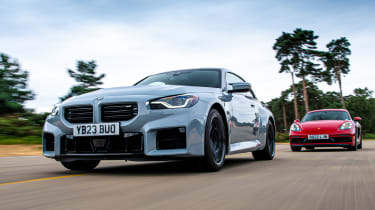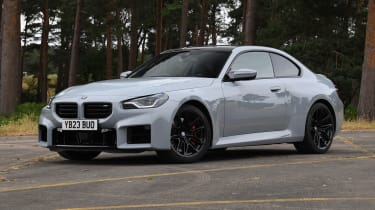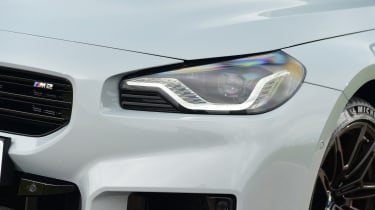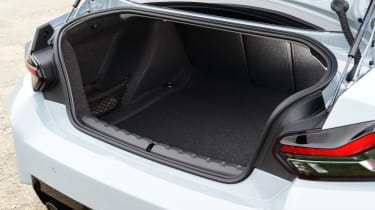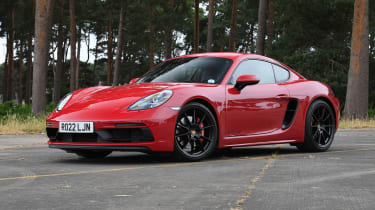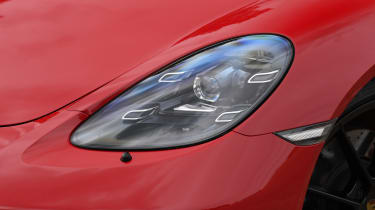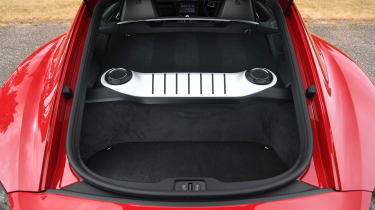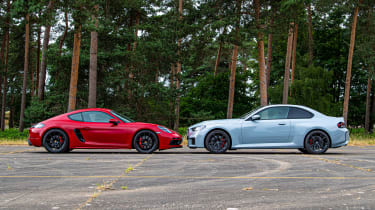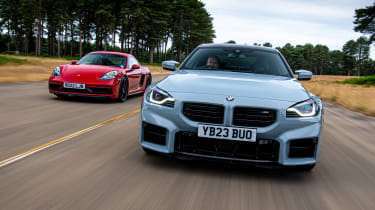BMW M2 vs Porsche 718 Cayman GTS: 2023 twin test review
We’ve been impressed by the BMW M2 so far, but how does it fare against the performance-focused Porsche 718 Cayman GTS?
In a very short space of time, the all-new BMW M2 has proven to be a sensation. We have been blown away by our first encounters with it, both abroad and in the UK, and it proved itself able to show many of the best M car traits when we lined it up against one of its ancestral heroes, the E46 M3 CSL. But now it’s time to take on the best that the modern class has to offer.
The Porsche 718 Cayman has been around for some time, but as an overall package, it’s very hard to beat. It came into its own when Porsche reintroduced the flat-six engine, and we’re pitching it against the M2 in GTS trim.
|
BMW M2 |
Porsche 718 Cayman GTS 4.0 PDK | |
|
Price: |
Price: £64,890 |
Price: £75,832 |
|
Powertrain: |
Powertrain: 3.0-litre 6cyl twin-turbo, 454bhp, eight-speed auto |
Powertrain: 4.0-litre 6cyl, 395bhp, seven-speed auto |
|
0-62mph: |
0-62mph: 4.1 seconds |
4.0 seconds |
|
Test efficiency: |
Test efficiency: 30.2mpg/6.6mpl |
30.5mpg/6.7mpl |
|
CO2: |
220g/km |
230g/km |
|
Annual VED: |
£570 |
570 |
BMW M2
We’ll dive into the M2’s on-paper stats and on-road manners in great detail over the coming pages, but at £64,890, it looks like tempting value for money among performance car rivals; that’s not a trait we normally associate with a hot BMW.
Tech highlights
It isn’t a stretch to argue that previous versions of the M2 have been held back ever so slightly in order to avoid stepping on the toes of the M4. But that’s not so much the case any more, because this G87 generation actually shares its basic underpinnings and S58 engine with its big brother.
The chassis is a little shorter, with 110mm less distance between the front and rear axles, but BMW quotes the same 1,800kg kerbweight for the M2 as it does for the rear-wheel-drive M4. However, while the M4 is also available with four-wheel drive (which adds an extra 50kg), the M2 sends everything to the back tyres alone. And with the 3.0-litre twin-turbocharged straight-six producing a hefty 454bhp and 550Nm, that’s a lot for the 285mm-section Michelin Pilot Sport 4 S rubber to handle.
Further differentiation from the M4 comes with the transmission, because while in the UK the M4 is auto only, M2 buyers get to choose from an eight-speed automatic gearbox or a six-speed manual. The manual costs £1,200 more, while it has a slower 0-62mph time (4.3 seconds to the auto’s 4.1) and poorer economy and emissions figures.
Safety: The M2 hasn’t been assessed by Euro NCAP, but the wider 2 Series Coupe range has. Surprisingly by BMW’s high standards, it only achieved a four-star rating. A safety-assist score of 64 per cent is its lowest rating, with its lane-keep tech not proactive enough for NCAP’s assessors– although we would argue that it’s not as intrusive as some systems.
On the road
Few cars are as entertaining yet reassuring as the M2. In terms of speed, sophistication and refinement, it delivers a brilliant spread of abilities.
Around town: The first surprise in the M2, particularly when compared with its M4 sibling, is just how smooth the ride feels. The comfort and modest dimensions make it an easy car to live with.
A & B-roads: Take the M2 by the scruff of the neck and it immediately reveals an engaging personality. Bury your right foot and the engine takes a deep breath before firing the M2 towards the horizon. There’s a 0-62mph time of just 4.1 seconds (or 4.3 seconds for the manual), and at any revs and in any gear, it’s seriously, startlingly quick.
The chassis is the real star of the show, though. That forgiveness in the suspension translates into some body roll in corners, but not at the expense of control. Instead, it allows the M2 to communicate with the driver constantly, relaying in detail how much grip is left at every stage, although the feedback is almost always “plenty”.
By adding or taking away throttle through the turns, the M2 willingly and quickly responds; the way the adjustability of the chassis puts you in control of the car’s behaviour is incredibly satisfying.
There’s plenty of travel in the springs, too, so even over broken roads, it’ll not get flustered when pushed. On smoother roads, it’s possible to increase the firmness of the adaptive dampers, but the same character and sophistication remain.
Motorway: The wide track and balanced chassis help at higher speeds, where the M2 has superb stability. The engine settles down and can deliver mpg figures well into the thirties, while road and wind noise are fairly well suppressed, too.
Ownership
The standard 2 Series cabin is a fundamentally solid starting point from which to apply M upgrades; build quality is superb, the layout is neat and functional, and even though the climate controls are operated via the touchscreen, the system is among the more intuitive of its type to use. The front scuttle, and therefore the dashboard top, is quite high, so forward visibility could be slightly better, but we’re nit-picking.
The most obvious upgrade from the standard 2 Series to the M2 is the steering wheel. There’s extra carbon fibre, and it also gains a pair of red M switches above the horizontal spokes; each can be programmed to store the driver’s preferred powertrain, chassis and exhaust settings.
New, more tactile paddles sit just behind those buttons, while the shifter on the centre console is a more traditional lever in place of the small rocker selector switch that’s fitted to other models in the 2 Series family. As with the rest of the range, backlit door panels feature, but instead of the traditional white light, this now glows in the blue, violet and red colours of BMW’s M division.
All BMWs come with a three-year warranty and three years of breakdown cover from new, although the company’s 24th-place finish in our 2023 Driver Power satisfaction survey is rather disappointing.
On a run that included plenty of motorway driving, the M2 averaged an impressive 30.2mpg. Saying that, its 52-litre fuel tank isn’t huge, so the range isn’t phenomenal if you start using more of its performance on a track day, for example.
Storage: The M2 benefits from the same useful storage spaces you get in other 2 Series models. The door bins are fairly roomy, and the large cubby at the base of the dashboard is more than large enough for modern smartphones. Four USB ports mean that all occupants can keep their devices topped up, and there’s wireless charging, too.
Practicality
A two-door coupe is never going to rival a family SUV for space, but the M2 is a very practical car by GT standards.
Rear Space: As long as the front-seat passengers are less than six feet tall, then the M2 gives just enough kneeroom for another two adults to slot in behind. Headroom is a little on the cramped side, but as occasional seats they work fine – especially when the Cayman doesn’t have any back seats at all.
The BMW’s rear seats even come with Isofix mounting points as standard, so it’s still possible to install a child seat – once you’ve wriggled it through the gap between the door opening and front seat.
Boot: It’s possible to load a large suitcase or a set of golf clubs into the M2’s 390-litre boot. However, the opening isn’t the largest, so a little creativity is needed when packing for a longer trips.
What to buy?
Which engine and trim we’d choose
- Engines: The M2 is offered with just one configuration; its 454bhp raises it 85bhp beyond the next most potent M240i.
- Trim: Only one trim level is available, but the range of option packages helps buyers customise their cars.
- Options: Those packs include the £2,305 M Driver’s Pack, which raises the speed limiter to 180mph, while BMW throws in an ‘M Intensive Training’ course, too. The £9,095 M Race Track Pack includes the M Driver’s Pack and also adds carbon-fibre bits inside and out, including the bucket seats.
- Our choice: The M Driver’s Pack adds just a little extra sharpness for another £2,305.
Porsche 718 Cayman GTS 4.0
The Cayman GTS in our pictures is equipped with a manual gearbox, but in the interests of keeping a level playing field with the BMW, the model we’re testing comes with the PDK auto transmission, which is a £2,532 extra. At £75,832 before options, the Porsche is the more expensive car, but can it expose any weaknesses in its rival?
Tech highlights
Uunlike the M2, the 718 Cayman (alongside the open-topped 718 Boxster) was developed with the sole purpose of creating Porsche’s entry-level sports car, so it doesn’t share its architecture with anything else. Given that this fourth-generation Cayman made its debut back in 2016, it’s not loaded with the latest tech, but it does benefit from many features that matter for a performance car.
The rear axle features a mechanical limited-slip differential, for example, and the adaptive engine mounts can firm up to increase precision during harder cornering, yet slacken off to improve comfort the rest of the time. The dampers are also electronically adjustable, while the GTS sits 20mm lower than the standard Cayman.
The mid-mounted engine, meanwhile, is a mildly detuned version of the 4.0-litre flat six used by the Cayman GT4. Its maximum of 395bhp is down on the M2’s, but what’s telling is that this amount arrives at 7,000rpm, and the red line is set at 7,800rpm. Peak torque is 430Nm and also chimes in at a heady 5,500rpm – only 750rpm short of the BMW’s peak power.
This, then, is an engine that needs revs to get the best out of it.
Safety: The 718 Cayman range hasn’t been assessed by Euro NCAP. Given that it’s a much older design than the M2, it doesn’t feature the latest advanced safety tech, such as blind-spot warning or lane-keep assist, either.
On the road
If the M2 instantly reveals what it’s all about, the Porsche’s qualities are a little more nuanced. That doesn’t make it any less brilliant to drive, though.
Around town: Beside the impressively composed BMW, the Porsche feels noticeably firmer at low speeds. The ride isn’t harsh, because the damping is very precise and controlled, but you get jostled about in the seat more than in the BMW.
On the other hand, the Cayman’s dual-clutch gearbox is brilliant, because the car pulls away smoothly from a standstill and responds quickly the rest of the time.
A & B-roads: It takes longer to appreciate the Porsche’s finest qualities on the road, even if it’s immediately clear that its steering is beautifully weighted and more precise than the BMW’s. While the M2’s limits are easy to reach, thanks to its big, torquey engine, it takes more commitment in the Porsche for it to reveal what it can do.
That firm low-speed ride becomes more composed the harder you push, delivering remarkable control, even on the toughest roads. Its weight advantage over the BMW becomes clear with its superb agility, and grip is very strong.
When you reach its limits, it feels so perfectly balanced that you have utter confidence in enjoying its performance.
Here, however, it’s the engine that’s a highlight. The flat six relishes the task of wringing out every single rev before shifting up to the next gear, and it sounds utterly glorious while doing so. Get the start just right, and it’ll even outsprint the M2 from 0-62mph by a tenth of a second.
Motorway: A slight issue with the Porsche at speed is that it transmits more road noise into the cabin, especially from the rear tyres.
Ownership
From the outside, the GTS benefits from a few specific upgrades to set it apart from the rest of the 718 Cayman line-up. Beyond the uprated suspension that brings with it a subtle 20mm drop in ride height, the front apron is specific to this model, as are the tinted headlamps and exhaust tips finished in gloss black.
On the inside, many of the features you see on our test car, such as the red stitching, seatbelts and rev counter, are part of a GTS interior package that costs £1,365. The overall cabin design is starting to look a little old hat beside the M2, but the important qualities, such as the driving position and location of all of the major controls, are still as close to perfect as you’ll find in any new car.
The steering wheel is great to hold, and the rim is thinner and less squidgy than the M2’s, which to some extent reinforces the impression of precision that the Cayman’s rack delivers.
The finish and materials used are to the high standards you would expect from a marque that has topped our Driver Power Manufacturer customer satisfaction survey for the third year in a row. Build quality, along with driving dynamics and design, were all areas which our Porsche-owning readers ranked their cars above any other brands in 2023.
Given the performance on offer, a return of 30.5mpg is also a very impressive figure. Of course, that number will slip down with harder use, but a 64-litre tank is 12 litres greater than its rival’s, so it’ll still travel further between refills.
Storage: There isn’t much to shout about in terms of cabin storage in the Cayman. The central armrest bin is too narrow for smartphones, so it’s only really suitable for items like keys, while the door pockets are very slim. The glovebox is fine, and above it are a pair of cup-holders that neatly pop out from behind the trim panel. Shorter occupants can make some more space behind the seats, too.
Practicality
When designing a mid-engined sports car, optimal positioning of the driver and powertrain is the top priority, with additional storage space lower down on the list of importance. While back seats have to make way for an engine here, the front seats have lots of room, and there’s a reasonable amount of luggage space.
Boot: The Cayman’s layout certainly compromises the amount of storage available. Out back, the 182-litre boot is very compact and a little awkwardly shaped. The opening is fairly large, though, so it’s easy to squeeze a soft bag inside.
However, with no engine up front, the GTS also benefits from an extra 150-litre space ahead of the cabin. This area is quite deep, so is better suited to more bulky suitcases than the space in the back. While neither boot nor bonnet is powered, their latches pop open electrically with buttons on the keyfob.
What to buy?
Which engine and trim we’d choose
- Engines: The Cayman range starts with turbo flat fours, but the six-cylinder models like the GTS are the ones to have.
- Trim: GTS is itself a trim level, so it’s over to the lengthy options list to give the Cayman some unique features.
- Options: The customisation list for the Cayman range is huge. The cabin feels much more plush when the dashboard and door trims are covered in leather, and it’s even possible to trim the steering column shroud, too. Our car’s Carmine Red paint costs £1,824, with 14 other shades to choose from.
- Our choice: In terms of value and performance, the GTS is the sweet spot of the line-up.
Results
Which car comes out on top?
Winner: BMW M2
The previous M2 was a very tough act to follow, but BMW has somehow been able to improve almost every area with this latest version. It’s thrilling to drive and incredibly quick,yet it manages to offer impressive refinement and practicality, too.
It also captures some of the character that we loved so much about previous M cars and thrust them into the modern era. That it offers such a well rounded package at a price that undercuts most key rivals is just the icing on the cake.
|
Pros |
Cons |
|
Rapid performance |
Auto box isn’t the slickest |
|
Sharp handling |
Engine could sound better |
|
Huge character |
Occasionally feels its weight in this company |
|
Ride comfort |
Runner up: Porsche 718 Cayman GTS 4.0
The Cayman has been around for so long that it’s no longer a surprise when it delivers such a strong performance in a comparison test.
What delights most is that even beside the latest and best fast coupe around, in GTS form it can match and even surpass it in some areas. The engine and gearbox are divine, while the chassis is just as special. Its lack of versatility holds it back here, but if that’s not an issue for you then it remains a fabulous swansong before the EV replacement arrives.
|
Pros |
Cons |
|
Wonderful engine |
Less practical than BMW |
|
Snappy manual and automatic gearboxes |
Road noise |
|
Incredible chassis |
Long gearing |
|
Build quality |
Dated infotainment tech |
Rivals and other options
The BMW M2 wins our twin test, but what else is out there?
- Same class: Alpine A110 S
- Same money: Mercedes-AMG A 45 S
- Used: Audi R8 V10 Coupe
- Used: Porsche 911 Carrera
- Coming soon: Alfa Romeo 6C
The great debate
What the Auto Express test team would do…
Sean Carson, associate editor: “The comparison between these two is fascinating. Both are brilliant, but while the BMW shows most of its strong hand instantly, it takes much longer to appreciate the brilliance of the Porsche. Whichever you prefer, coupe buyers are spoiled for choice.”
John Mcllroy, deputy editor: “WIth the M2 proving to be so brilliant and the M3 now available as a practical estate-bodied Touring model, we’re starting to question who would actually want the regular M4. Yes, it’s impressive, but in many ways it’s overshadowed by several models from its own stable.”
Dawn Grant, picture editor: “We weren’t too sure about the M2’s style in the early photos, with those square intakes and boxy arches looking a little clumsy at first. But up close it’s much more convincing. It has a joyfully over-the-top, cartoonish look that’s perfectly in keeping with its character.”
Steve Fowler, editor-in-chief: “Porsche has confirmed that the replacement for the Cayman and Boxster will sport an electric powertrain. While the brand has proven it can make EVs handle well with its Taycan, it’ll be interesting to see if the new model can live up to the magic of its combustion predecessors.”
Dean Gibson, senior test editor: “It’s not just the Germans who can make an accomplished and rapid two-door – Lotus is throwing its hat into the ring with the superb Emira. It retains the ride-and-handling brilliance of earlier Hethel products, with a little more quality to boot.”
Which would you buy? Let us know in the comments section below…
Specs and prices
|
BMW M2 Coupe |
Porsche 718 Cayman GTS 4.0 PDK | |
|
Petrol or diesel |
Petrol |
Petrol |
|
MPG (WLTP) |
30.2 |
30.5 |
|
Fuel price |
1.44 |
1.44 |
|
P11D value |
£35,255 |
£38,705 |
|
Fill up |
£74.78 |
£92.03 |
|
On the road price/total as tested |
£64,890/£64,890 |
£75,832/£79,021 |
|
Residual value (after 3yrs/36,000) |
£38,168 (58.82%) |
£44,172 (58.25%) |
|
Depreciation |
£26,722 |
£31,660 |
|
Annual tax liability std/higher rate |
£2,608.87/£5,217.70 |
£2,864.17/£5,728.30 |
|
Annual fuel. cost (10k/20k miles) |
£2,165 (£4,329) |
£2,143 (£4,827) |
|
Ins. group/quote/VED |
42/£2,230/£570 |
42/£992/£570 |
|
Service costs (3 years) |
£0 |
£627 |
|
Length/wheelbase |
4,580/2,747mm |
4,405/2,475mm |
|
Height/width |
1,403/1,887mm |
1,276/1,801mm |
|
Engine |
6cyl in twin-turbo/2,993cc |
6cyl flat/3,995cc |
|
Peak power |
454bhp/6,250rpm |
395bhp/7,000rpm |
|
Peak torque |
550Nm/2,650rpm |
430Nm/5,500rpm |
|
Transmission |
Eight-speed auto/rwd |
Seven-speed auto/rwd |
|
Fuel tank capacity / spare wheel |
52 litres/repair kit |
64 litres/repair kit |
|
Boot capacity (front / seats up/down) |
N/A/390 litres |
150/182 litres |
|
Kerbweight/payload/towing weight |
1,800kg/252bhp/tonne |
1,510kg/262bhp/tonne |
|
Turning circle |
11.9 metres |
10.9 metres |
|
Basic warranty/recovery |
3yrs (60,000)/3 yrs |
3 yrs (unlimited)/3 yrs |
|
Driver Power manufacturer position |
24th |
1st |
|
Euro NCAP: Adult/child/ped./assist/stars |
82/81/67/64/4 (2022) |
N/A |
|
0-62mph/top speed |
4.1 seconds/155mph |
4 seconds/179mph |
|
Test economy / range |
30.2mpg/345 miles |
30.5mpg /429 miles |
|
WLTP combined |
28.8mpg |
28mph |
|
Actual/claimed CO2/tax bracket |
216 / 220g/km |
214 / 230g/km |
|
Number of airbags/Isofix points |
Seven/three |
Six/one (£140) |
|
Parking sensors/camera |
F&r/360 |
F&r/£509 |
|
Lane-keep assist/blindspot/AEB |
Yes/yes/yes |
No/£453/no |
|
Climate control/adaptive cruise |
Three-zone/yes |
Yes/£954 |
|
Leather/heated seats/wheel |
Yes/yes/yes |
Part/yes/£0 |
|
Metallic paint/LED lights |
£0/matrix |
£665/£1,185 |
|
Keyless entry & go/powered tailgate |
Yes/yes |
£546/no |
|
Sat-nav/digital dashboard/USBs |
Yes/yes/four |
Yes/no/two |
|
Online services/wireless charging |
Yes/yes |
No/no |
|
Apple CarPlay/Android Auto |
Wireless/wireless |
Yes/no |

